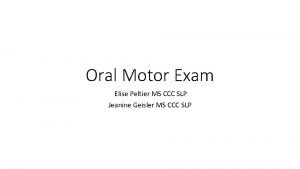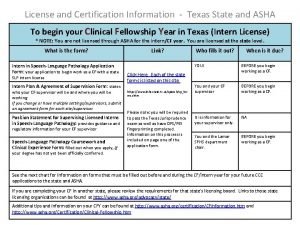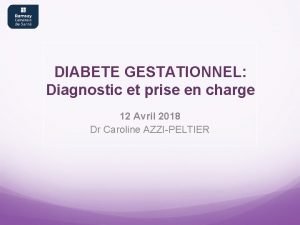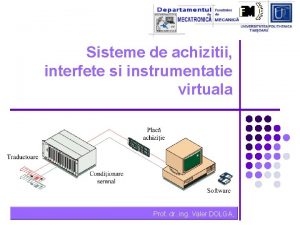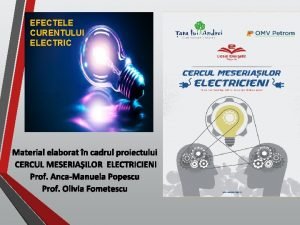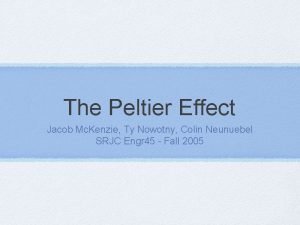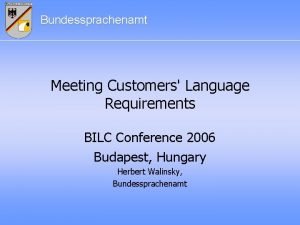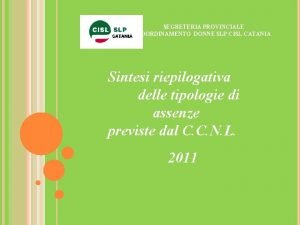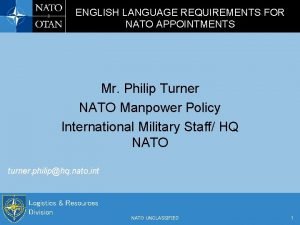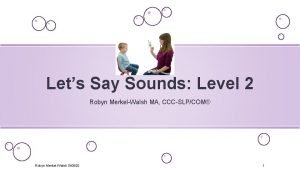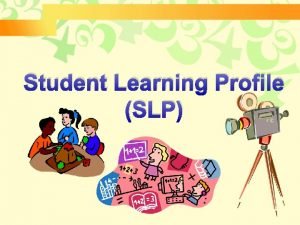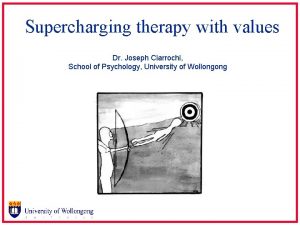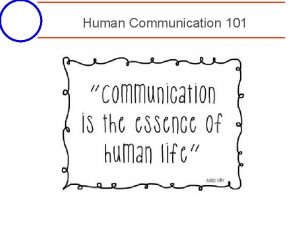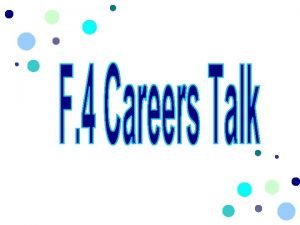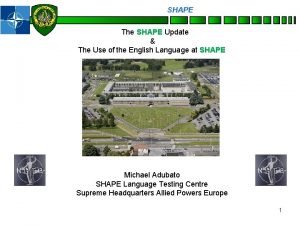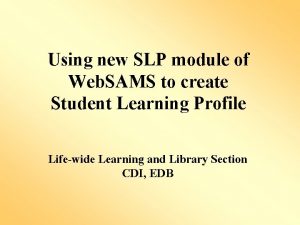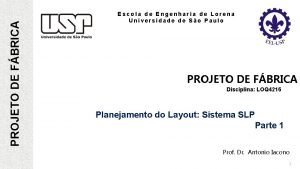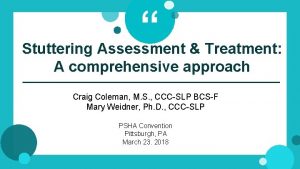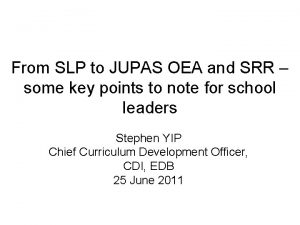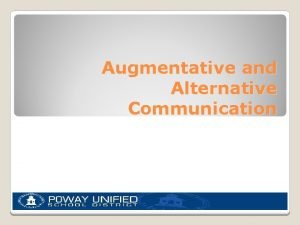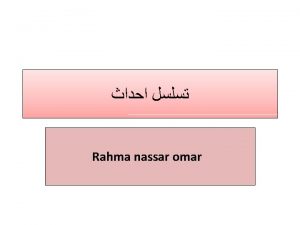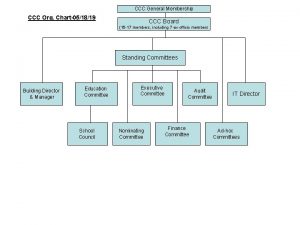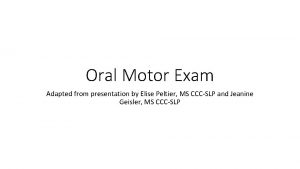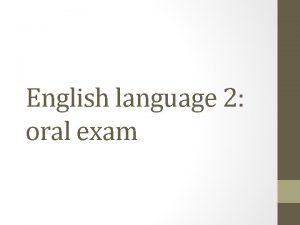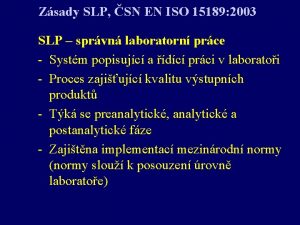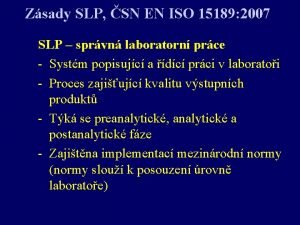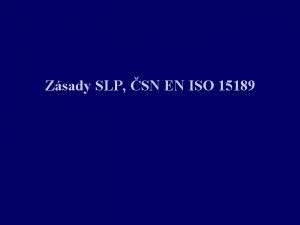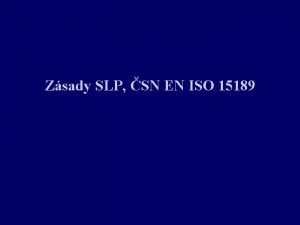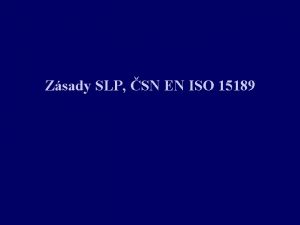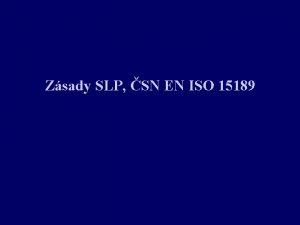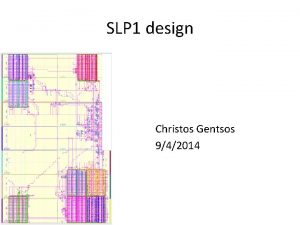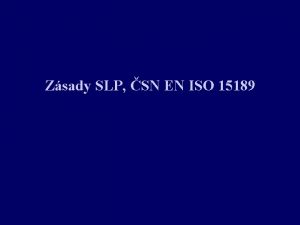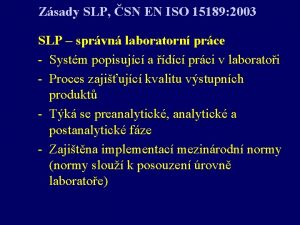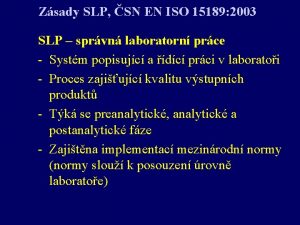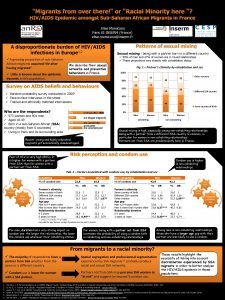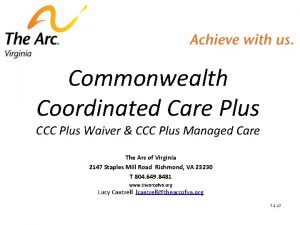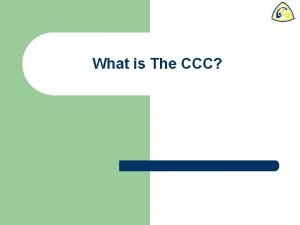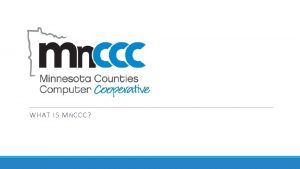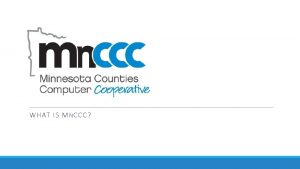Oral Motor Exam Elise Peltier MS CCC SLP























- Slides: 23

Oral Motor Exam Elise Peltier MS CCC SLP Jeanine Geisler MS CCC SLP

What is an Oral Motor Exam • Determine the structural and functional adequacy of the oral mechanisms • A variety of medical professionals may complete dentists, doctors and speech language pathologists.

Alternative terminology • Oral Motor Exam • Oral Peripheral Exam • Oral Mechanism Exam (Oral Mech) • Speech Mechanism

Why do an Oral Motor Exam ? • Stroke ( CVA) • Feeding and Swallowing • Aritculation Disorder • Motor Speech Disorder • Dysarthria • Apraxia

Tools • Gloves • Tongue Depressor • Pen Light • Small hand held mirror • Watch ( stop watch) • Other helpful tools : sucker, cotton guaze

What structures do we look at ? • Face • Lips • Teeth • Tongue • Jaw ( mandible) • Hard/Soft Palate • Cheeks

How do we illicit desired results • Adult clients • Give direct verbal instructions • Model

Target: Facial Symmetry • Have subject look straight at you • Are facial features symmetrical?

Target: Tongue • Elicitation • Stick straight out, left then right, left right quickly, elevation, retraction, protrusion and lateral movement against resistance ( cheek or tongue blade) • Observations • Look for symmetry and range of motion, • size and evidence of fasiculations. • https: //www. youtube. com/watch? v=xuwdv. BXcr 30 • Assess ability to exert force against resistance • Assess coordination of fast movements

Target: Lips • Elicitation • • • Smile Pucker Open Close Tight Puff up cheeks, hold against resistance • Observations- Look for symmetrical movements, extent of movements, ability to close completely and hold against resistance

Target: Oral Cavity and Velum • Elicitation • Open Wide • Say “ah” or “E-E-E-” • Observation • Look at conditions of teeth, any dentures or partials? • Watch for extent and symmetry of velar elevation and pharyngeal constriction

Target: Voice/Airway Protection • Elicitation • • Maximum phonation duration S: Z ratio, pitch glides Volitional cough and Throat clearing • Observations • Listen for intensity, pitch and quality • Listen for breathy, horas/harsh, strained, wet/gurgly • Listen for hyper or hyponasality

Special considerations for adults • Hearing loss or auditory comprehension - check for hearing aids, write instructions, model • Adults with Apraxia • Blow a kiss, smile • Give a spoon or straw

How can we describe/ measure • We can describe muscle and function and movement using STARRS • • • MUSCLE STRENGTH MUSCLE TONE ACCURACY OF MOVEMENT RANGE OF MOVEMENT SPEED OF MOVEMENT STEADINESS OF MOVEMENT

Get your ped to participate! • Ped friendly language • Glove considerations • Extra-Oral -> Intra-Oral • Use of lollipop or pudding • Flavored tongue depressors • Flashlight with lights off • Take turns looking into each others mouth • “Simon Says” game • Assess during meal or “snack”

Anatomy • Age 5 is when anatomy + physiology (for feeding/swallowing) is like that of an adult • Structures and their relationship are previously designed to provide stability, control, and airway protection

Structural Considerations • Cleft palate or lip

Structural Considerations cont. • Tongue tie (ankyloglossia) or Lip tie

Hypotonic Facial Characteristics

Drooling • Assess why - Postural Control - Oral sensory responses - Oral-motor skills - Swallowing ability - Cognitive level - Structural Problems - Dental/Occlusion problems - Medications - Diet

Teeth • Normal Occlusion • Class II Malocclusion (Overbite) • Class III Malocclusion (Underbite)

Teeth cont. • Cross Bite • Open Bite • Tooth Decay

Assessing for Apraxia of Speech • Diadochokinetic Rate - Repeat “papa” - Repeat “tata” - Repeat “kakaka” • Alternate Motion Rate - Repeat “pataka” • Nonspeech tasks (assess for oral apraxia)
 Oral mechanism exam slp
Oral mechanism exam slp Asha certification
Asha certification Peltier effect
Peltier effect Diabète gestationnel diagnostic
Diabète gestationnel diagnostic Efectul peltier
Efectul peltier Efectele curentului electric termic
Efectele curentului electric termic Mc
Mc Bundessprachenamt slp test
Bundessprachenamt slp test Slp cisl catania
Slp cisl catania Dogboss bsc
Dogboss bsc Nato language levels
Nato language levels Multiversidad latinoamericana slp
Multiversidad latinoamericana slp Robyn walsh slp
Robyn walsh slp Slp student
Slp student Slp dominance
Slp dominance Slp quotes
Slp quotes Slp self account sample
Slp self account sample Slp 3322
Slp 3322 Sams slp
Sams slp Slp jupas
Slp jupas Slp
Slp Craig coleman slp
Craig coleman slp Jupas slp
Jupas slp Slp consult
Slp consult
